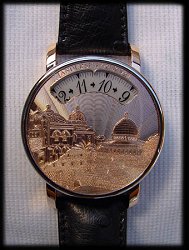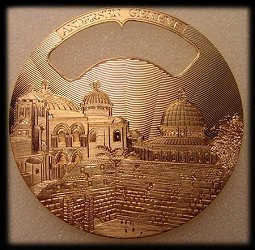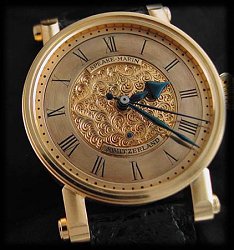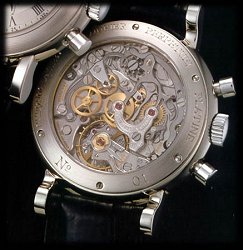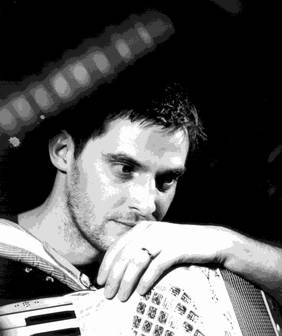 |
| MS: Michael Sandler - TimeZone.com KE: Kees Engelbarts |
MS: Could you begin by telling us a little about how you got started with engraving?
KE: I know it might sound strange, but the reason I started engraving, was a water balloon-throwing contest. I won a medal that I had to pick up at an engravers workshop in my hometown, 's-Heerenberg in the Netherlands. He was busy hand-engraving little cupids and I fell in love with the craft. He gave me the address of the school in Schoonhoven / Holland, so next day I enrolled. My first hand-engraving lesson was a disaster, I stabbed an engraving tool in my left hand, and I still wear the scar. My teacher though, said it was a good omen.
MS: Did you go to school to learn your art, or are you self-taught?
KE: Both! As I said before, I went to school in Schoonhoven for four years. After having finished my school I went to a "Fachhochschule für Edelstein und Schmuck Gestaltung" in Idar-Oberstein / Germany, where I studied for three years. During my vacations I worked in Geneva to earn some money to be able to pay school in Idar-Oberstein. The self-taught part was that when I started working as a hand-engraver, I realized that I hadn't learnt any thing at school apart from preparing my tools. It took a lot of patience and perseverance to achieve a quality level, good enough to work in the high-end Swiss Watch Industry. I think it's impossible to learn this at any school. I'm still learning every day!!
MS: How did you make the transition to engraving watches and timepieces?
KE: My first contacts in Geneva where through a friend in Holland who'd asked me if I wanted to work in Geneva. The engraving-workshop where I started to work was specialized in engraving watches. That's the second time I fell in love, this time with the unique combination of esthetics and perfect technique, that a high quality watch should have. It was at that moment that I started dreaming about making my own watches one day…
MS: What made you decide to pack up your life and move to Switzerland?
KE: During my study in Idar-Oberstein, I met my wife Pascale in Geneva. To finish my school in Germany would have taken me two more years. I figured that it was time to really start working and also thought I'd learned enough in Germany so I decided to move to Geneva in 1994 and find a job there. I quickly found out that my character was not suitable with working as an employee, so I started my own workshop in 1996.
MS: What were your first projects when you first started in the watch industry?
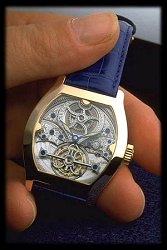 Click image to see full-size |
MS: Could you tell us about some of your more interesting or challenging projects?
KE: Artistically seen, my most challenging projects are my own watches. To start off with nothing and to end up with your own watch, to me, is like magic. Of course I also did a lot of challenging projects for clients like the Platinum No. 1 for Jaeger-leCoultre, Erotic Automats for Antoine Preziuso (prototype) and Svend Andersen. I like engraving prototypes and unique pieces. Every engraving can be as interesting and challenging as you want it to be. But sometimes the only challenge is to finish your work in time.
MS: Can you tell us some of the watch companies you've done work for? Specific models? Projects?
KE: I work (or worked) for some AHCI members, Antoine Preziuso, Svend Andersen, Philippe Dufour, Christiaan van der Klaauw, Peter Speake-Marin. Watch companies I've worked for are amongst others: Jaeger-leCoultre, Franck Muller (I was employed there for about 2 years and I'm still alive…), Hublot, Parmigiani, Harry Winston.
MS: What is Mokume Gane?
KE: The linked file describes this in some detail. Click here to read about Mokume Gane
MS: How long, on average, does it take to engrave a complete movement? Can you explain to us the steps that are involved in preparing the movement for engraving, and the engraving steps themselves?
KE: There's no average. It all depends on the movement and the decoration. The steps, in general, are:
Taking the movement apart - Cutting out of the main plate and the bridges (if it's a skeletonized movement) - Finishing of the edges - Fixing the pieces in a kind of wax so the pieces are held and supported - Draw (in rough lines) the decoration on the movement - Engraving of the movement - First engrave thin lines, parallel to the edges and around the holes - Engraving of the decoration - Finally, finishing the edges, filing, burnishing and polishing - Finishing of the surface - Plating of the movement (gold, rhodium, silver…)
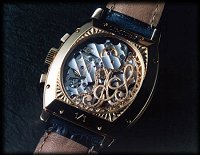 Click image to see full-size |
KE: Yes, the image to the right is a rotor I did by hand. The watch is a unique watch made by my friend Antoine Preziuso for a special customer. Movement is a Chrono 1185 Piguet, I think...
MS: Aside from Mokume Gane, are there other techniques you plan to try on watches which have not been done before? Are you limited only by the size of the plate, or are their limitations in the materials used as well? What materials are the most difficult to work with?
KE: Yes, I do have some ideas to use new techniques and materials in the future. What I need is time to do some try-outs. Of course I will keep you and your time-zone friends informed about my new stuff.
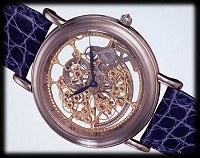 Click image to see full-size |
Most difficult materials to me are stainless steel (very hard), platinum (because of the irregular structure, also difficult to polish).
MS: Can you tell us about your own line of watches? Are all the pieces you make one-of-a-kind (unique), or do you also do series production?
KE: All watches I made, until now, are unique. I'd like to continue this way, but I don't exclude making small series in the future. Still, I want to give to each watch the attention it needs and deserves.
The technical part of most of my watches is done by my brother, Bart. He is an excellent watchmaker and guarantees that my watches are not only nice to look at, but also tell the correct time.
The movements I use are mostly new old stock vintage movements that I buy from watchmakers in small amounts. It's hard to obtain movements from manufacturers because they only want to sell minimum quantities of one hundred pieces.
The cases of my watches are all handmade as well.
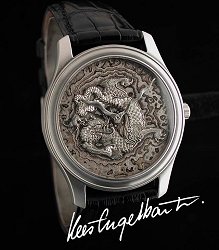 |
 |
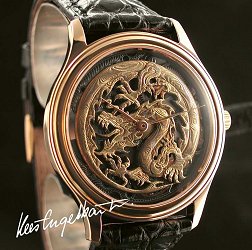 |
|
Click images to see full-size | |||
MS: You mention your cases are hand-made. I would imagine VERY few people are making their own cases by hand. Can you describe this process for us?
KE: Indeed, most cases of mass produced watches are made by CNC machines. It's cheaper and faster.
Since I only make unique pieces, every case has to be adapted to the movement I want to use, the thickness of the dial, etc. Before making the cases we have to make a technical drawing. Every single watchcase is made from a solid piece of gold or platinum. The case is turned on a lathe and milled to get the exterior shape. The inside of the case has to be very precise to be sure that the movement fits in nicely. Once the case has its final shape it's polished. Then we put in the glasses with joints as well as the tube for the winding crown. It all sounds quite simple, but it takes a lot of technical skills, precision and time to make a case like this.
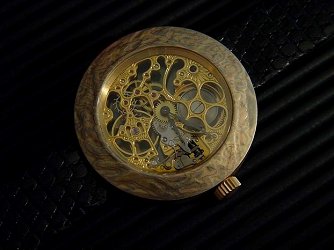 |
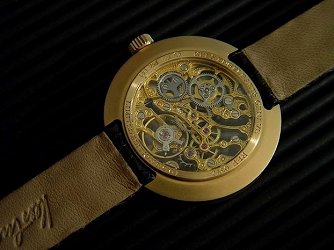 |
||
Click images to see full-size | |||
MS: Do you do custom engraving for customers on watches they already own? Can you tell us about a few of the requests you've received?
KE: If customers ask me to personalize their watches, I sometimes accept, sometimes refuse…
Most watch companies don't like the idea of someone changing their products. In most cases guarantee is void when you even take the watch apart. You could compare with the car industry where car manufacturers, in the past, didn't want other companies to "tune" their cars. Nowadays there are many companies that are specialized in customizing cars. Maybe in the future this will happen in watch making as well…
I've done some pieces for customers. You can change the dial, engrave the movement, open the back of the watch, engrave the watch case. You could also engrave a name, logo or coat of arms on the automatic rotor. Anything is possible but clients should understand that it's a lot of work…
MS: Is there a particular watch (or watches) that proved to be particularly challenging? Which piece which you've done in the past are you most proud of?
KE: No, every new engraving is a challenge. It has to be! You can play a song on the piano without being concentrated or motivated. If it sounds terrible, no problem, you play it again and try to do better. When engraving a watch (or something else) it has to be right the first time. That's the challenge!
The piece of art that I'm most proud of is my four year old son, Daan.
MS: What are your goals for the future?
KE: Being happy first of all!
For my work I would like to be free in what I do. Right now, being an independent engraver, I do a lot of work for watch brands. But the word "independent" is wrong in the sense that I "depend" on these watch companies to give me work. That's one of the reasons why I want to make my own watches. People don't know me very well yet, but I want to convince customers that the products that I make are unique and special. If I could make a living from the watches I make, that would be fantastic.
The hard part is that people are so focused on brands. Children at the age of 4 or 5 years only want Nike shoes because all the kids in school have them. Grown ups aren't much wiser, unfortunately. They sometimes buy watches of a certain brand to show off. Personally, I can't understand those people. I want to make watches for people that understand my work and the uniqueness of that work.
Thanks to articles in magazines and interviews like this I can maybe reach those people…
MS: Do you engrave items besides watches? If so, what other items do you work on?
KE: Wedding rings (without guarantee that the wedding lasts), bracelets, pendants, forks, knives, spoons…you name it.
MS: Do you collect watches yourself? If so, what sorts of watches interest you?
KE: No, I'm too poor and the money I have goes in material and movements to make my own watches. I would like to make a nice watch for myself one day (my wife already has one).
MS: Is there anything else you would like to tell the TimeZone community?
KE: "I'm a poor lonesome engraver and I'm far away from my goal…" (Lucky Luke)
I hope that the Time Zone community understands the passion that I have for my work and that they will tell others about me. Until now I have felt like singing under the shower, nobody hears you… even if you sing nicely!
Thank you for doing this interview with me, I hope readers will enjoy it as much as I did!
Note: Kees Engelbarts can be reached via email at mail@kees.ch.
All Rights Reserved
